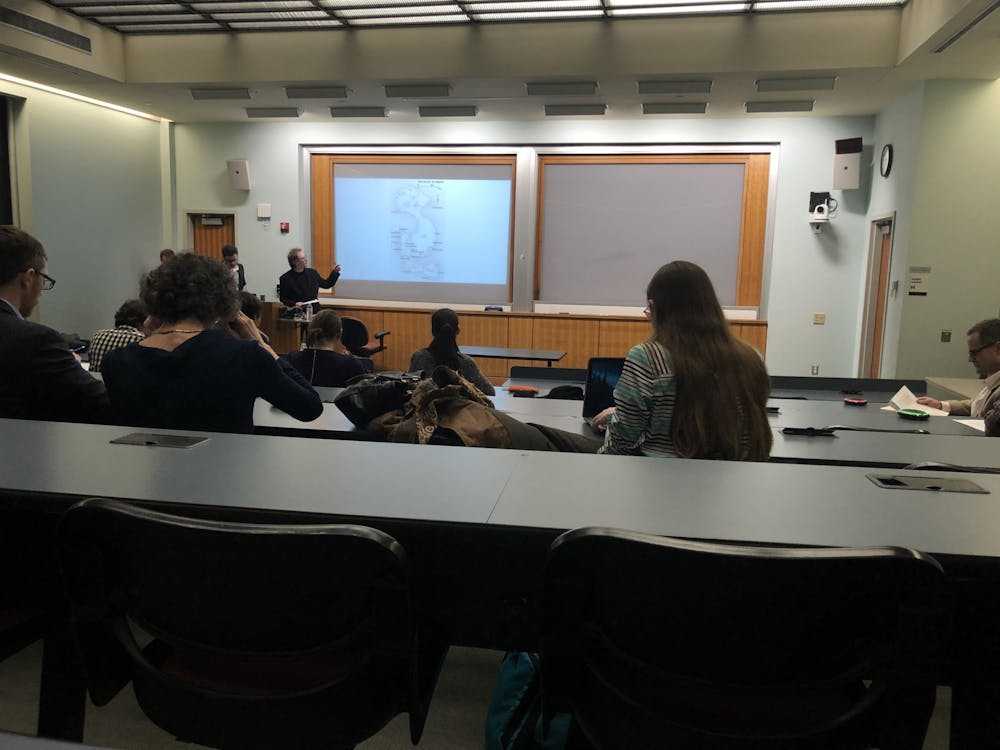Andrew Laird, the John Rowe Workman Distinguished Professor of Classics and Humanities at Brown University, gave a presentation titled “Aztec Latin: Renaissance Education and Native Traditions in 16th-Century Mexico” on Thursday, Feb. 6. The talk was the 34th Annual James W. Poultney Memorial Lecture, sponsored by the Classics Department.
Laird divided his presentation into four sections to illustrate the adaptation of Latin language to the Aztec society and its effects on literature and culture.
He discussed the first recorded instance of Aztec students receiving a Latin education from European elites, as Latin had been taught in the Franciscan monasteries. Laird explained that the Spanish brought the monasteries and their education system with them when they colonized Mexico.
“That was to ensure the young men from native elites could have a higher education. This was a way of consolidating Spanish control over a newly subjugated population by creating an appropriately trained governing class,” Laird said.
Laird stated that many of the Mexican elites who learned Latin would go on to become the teachers for their communities. He explained that the Latin curriculum is built around grammar, allowing students to learn argumentative and rhetorical skills.
“[It] offered training in critical thinking, essay writing and speech making. This allows students to become judicious local leaders,” he said.
Laird highlighted the fact that the translation of Latin into the lingua franca, Nahuatl, of the Aztecs, offered an interesting chance to see the impact of a foreign language on local culture with the addition of vocabulary.
Laird explained that Mexicans came to recognize writing in Latin as a demonstration of education and intelligence, as well as finding practical reasons to do so.
“It is recognized by Mexicans as a form of refined elegance,” Laird said. “They could best show off their learning by citing classical and Christian sources in Latin.”
In the last section of his presentation, Laird discussed the impact of Greco-Roman texts on the new generation of Mexican elite. Laird pointed out that there was a separation between the new generation of Latin-educated Mexican elite and their understanding of their history and ancestors.
Laird argued that the addition of the snake figure on the Mexican flag was emblematic of European subjugation of the country.
“The snake is an attempt to dignify the Mexican sign,“ Laird said. “Just to make it readable to European eyes.”
Senior Tommy Tripp explained in an interview with The News-Letter that the talk provided new insights into the classics discipline that he had not encountered in the classroom.
“You dive deeper into other areas of discipline that you don’t normally think about, that have a bigger impact on other parts of the world,“ Tripp said.
Giacomo Loi, a third-year PhD student in the Classics Department, stated that the talk brings attention to a subject that was often closed off in academic studies.
“This is the direction of opening up the subject and saying there are other people who are not Roman or Greek who are part of this story, and we want to be told about it,“ Loi said.
Loi explained that the talk offered him new inspiration in his own field of research.
“I work on classical literature in modern Hebrew, and seeing the same questions in totally another part of the world and time frame confirms the question that we should always ask: What are people doing with the tradition and what meaning does it have?“ Loi said.





